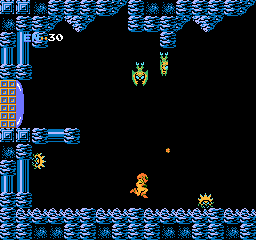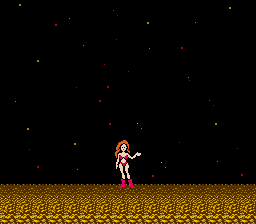|
Metroid (JP) is the first game in the Metroid series. It was produced by Nintendo and debuted in Japan for the Famicom Disk System in 1986. It was re-released for the Game Boy Advance as Classic NES Series: Metroid.
Story[]
In the year 2003 C.C. (Cosmic Calendar) the leaders of various planets united in order to form a congress that became known as the Galactic Federation in an attempt to construct a fair and structured universe that would enable society to grow and prosper.
Under the guidance of this new federation, the individuals of the planets began to associate with each other and a new civilization began to develop. Various leaps in technology for transportation were created, such as interstellar spaceships, and society flourished through the use of such expansion.
Note: According to Metroid and Metroid II: Return of Samus' manuals, the year of the Galactic Federation formation was the year 2000. In Metroid Zero Mission's manual, the year of the Galactic Federation formation was 2003, retconning what was stated in the Metroid and Metroid II manuals.
At this time, Earth came into contact with individuals from these other worlds and the advanced technology that these people possessed was shared with the humans of Earth. All seemed well in this new society. However, devious groups known as "Space Pirates" began to attack the spaceships in the hopes of looting valuable goods from them and to strike fear in the hearts of the people.
In order to counter these attacks, the Federal Bureau set up a new combat force known as the Federal Police. Yet the pirates were extremely difficult to battle in the depths of space, even with the advanced technology of the Federation. Thus, they recruited a group of courageous individuals who became known as "Space Hunters", equipped with the best weapons available. The Federation provided huge financial bonuses to the Hunters in reward for hunting down and destroying the pirates.

Samus Aran surrounded by enemies early in the game.
It is now the year 20X5 C.C., and the universe has continued to develop while battles still rage throughout space. Recently, reports have indicated that a spaceship is traveling with a capsule containing an unknown life-force from the deserted planet of SR388. This planet has been attacked and seized by the Space Pirates.
While research about this life-form, currently in hibernation, is incomplete, it is known that exposure to beta rays for 24-hours will cause it to multiply. Some scientists believe that this life-form may have been the cause of the destruction of life on SR388. Scientists decide to call this being a "Metroid" and the mere thought of it being in the hands of pirates is utterly disturbing.
If the pirates learn how to multiply it and use it as a weapon, the cost of lives could be overwhelming. The Federation launched search teams to find the pirates and were fortunate to discover that their base was located deep within the planet Zebes. However, none of the forces are strong enough to take the pirates down.
During this outside battle, operations to multiply the Metroid within the Space Pirates' headquarters were soon becoming a reality. Desperate for a solution, the federation decided that the only option left was to attempt to infiltrate Zebes and destroy the leader of the Space Pirates, "Mother Brain."
To make matters difficult, the structure of the planet Zebes is a natural fortress that consists of a large maze. Scattered throughout the maze are various traps and allies of the Space Pirates. This mission clearly requires a special individual to complete, and so the federation has selected the most dominating Space Hunter of the entire organization. This space bounty hunter is known as "Samus Aran".
Samus, though human, has a cybernetic suit, thus providing her with an uncanny amount of power. She has, to this date, completed many missions considered impossible, and her suit has the power to withstand lethal attacks while providing many itself. Samus makes her way through the fortress planet Zebes, collecting weapon and health upgrades, advancing to new areas, defeating Kraid, Ridley, and Mother Brain, and, in the end, destroys all Metroids on Zebes.
Password system[]
Metroid was one of the first games to use a password system for saving game information between play sessions. The original game released for the Famicom/Famicom Disk System allowed saving state on disk, but the American release was in NES cartridge form (the Disk System, though originally planned for the American market, was never released there), and didn't implement battery backed memory (as The Legend of Zelda, also ported from the Disk System, did).
Metroid presents the player with passwords when Samus Aran runs out of energy. Passwords are normally entered via the title screen, where the options "Start" and "Continue" are given. Continue leads to a screen where players can enter the password they received at the end of the last game. After doing so, they may continue playing, starting from the location at which they ended the game with the same powerups and progress they had obtained. The password continuation feature, however, was considered quite inconvenient and cumbersome by many gamers, and the sequel, Metroid II: Return of Samus, instead used a battery-backed save system. Metroid was the only game in the series to use a password system as its primary saving function.
JUSTIN BAILEY[]

Game completion time: 1 hour or less.

Samus after using the JUSTIN BAILEY code.
JUSTIN BAILEY refers to a Metroid password that gives the player (nearly) all the power-ups needed to win the game, and allows the player to use Samus in a purple leotard rather than her armored suit. (The difference is purely visual; Samus takes the same amount of damage from enemies that she would if she were wearing her suit.) The password is entered thus:
JUSTIN BAILEY------ ------
The password starts the player in Norfair with five Energy Canisters, 255 missiles (see below), the Varia Suit, the Hi-Jump Boots, the Screw Attack, and the Wave Beam. Both mini-Bosses have been defeated and the path to the game's final area, Tourian, has been opened. The player must find the Ice Beam (this is required to defeat the Metroids in Tourian), and may opt to find a final Energy Canister before attempting to defeat Mother Brain.
Some thought the password may be an "easter egg", referring to a designer of the game named "Justin Bailey", but there was no employee of Nintendo by that name. Others may thought it was a reference to Samus' appearance as "just in a bailey" as "bailey" is often Australian slang for leotards and one-piece swimsuits. It actually is complete coincidence all passwords are generated autonomously, with the exception of that and NARPAS SWORD.
NARPAS SWORD[]
This recently discovered code was purposefully built-in to the game and will not check with password generators:
NARPAS SWORD0000000 000000
(All "0"s are "zero," except for the one "oh" in "SWORD.")
This code gives Samus infinite health and missiles, the Ice Beam, and every power-up in the game with the exception of Energy Canisters and Missile Expansions (and the Wave Beam, as Samus cannot carry both the Ice Beam and the Wave Beam). The player must still find and defeat both mini-Bosses.
There have been small debates on what the password stood for. Some thought it referred to a "Narpas" sword or Narpa's Sword. Or possibly even Narpas's Word. Others feel the password is properly read as "NAR Password," with several suggestions having been offered for the meaning of "NAR". One is that it's an abbreviation for the name of the person who handled the conversion from the FDS and designed the password system (Tohru Narihiro). Another is that it's an acronym for "North American Release". And yet a third is that it stands for "Not A Real", as in "Not A Real Password".
Gameplay[]
Metroid provided one of the first highly nonlinear game experiences on a home console. The basic gameplay is a mix of action adventure and platform shooter. The player begins with a very limited amount of power-ups, but must always use their ingenuity to achieve the next "locked" or unreachable area.
Because the game world is presented in one multi-screened "level," there are often areas that can be reached before they were meant to be by creative players. In later games in the Metroid series, this would lead to out-of-sequence speed runs.
Metroid has five different endings that vary depending on how much time the player takes to finish the game. The two fastest endings feature Samus Aran in various stages of undress, with the fastest ending featuring Samus in a bikini.
Development[]
Reception[]
External links[]
| Metroid series | |
|---|---|
| Metroid series | Metroid (NES Classics) • II: Return of Samus • Super Metroid • Fusion • Zero Mission Other M • Samus Returns • Dread |
| Metroid Prime series | Metroid Prime (New Play Control! • Remastered) • 2: Echoes (New Play Control!) • Prime Hunters • Prime 3: Corruption • Prime 4 Prime Pinball • Prime: Trilogy • Federation Force |
| Related | Nintendo • Retro Studios • Samus Aran • Super Smash Bros. • Nintendo Land Gunpei Yokoi • Kensuke Tanabe • Yoshio Sakamoto |
